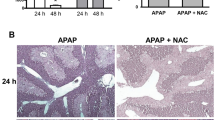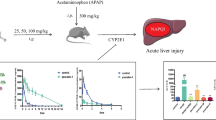Abstract
Introduction
Acetaminophen (APAP) is commonly ingested in both accidental and suicidal overdose. Oxidative metabolism by cytochrome P450 2E1 (CYP2E1) produces the hepatotoxic metabolite, N-acetyl-p-benzoquinone imine. CYP2E1 inhibition using 4-methylpyrazole (4-MP) has been shown to prevent APAP-induced liver injury in mice and human hepatocytes. This study was conducted to assess the effect of 4-MP on APAP metabolism in humans.
Methods
This crossover trial examined the ability of 4-MP to inhibit CYP2E1 metabolism of APAP in five human volunteers. Participants received a single oral dose of APAP 80 mg/kg, both with and without intravenous 4-MP, after which urinary and plasma oxidative APAP metabolites were measured. The primary outcome was the fraction of ingested APAP excreted as total oxidative metabolites (APAP-CYS, APAP-NAC, APAP-GSH).
Results
Compared with APAP alone, co-treatment with 4-MP decreased the percentage of ingested APAP recovered as oxidative metabolites in 24-hour urine from 4.48 to 0.51% (95% CI = 2.31–5.63%, p = 0.003). Plasma concentrations of these oxidative metabolites also decreased.
Conclusions
These results show 4-MP effectively reduced oxidative metabolism of APAP in human volunteers ingesting a supratherapeutic APAP dose.
Trial Registration
ClinicalTrials.gov Identifier: NCT03878693




Similar content being viewed by others
References
McGill MR, Sharpe MR, Williams CD, Taha M, Curry SC, Jaeschke H. The mechanism underlying acetaminophen-induced hepatotoxicity in humans and mice involves mitochondrial damage and nuclear DNA fragmentation. J Clin Invest. 2012;122(4):1574–83. https://doi.org/10.1172/jci59755.
Salmonson H, Sjoberg G, Brogren J. The standard treatment protocol for paracetamol poisoning may be inadequate following overdose with modified release formulation: a pharmacokinetic and clinical analysis of 53 cases. Clin Toxicol (Phila). 2018;56(1):63–8. https://doi.org/10.1080/15563650.2017.1339887.
Marks DJB, Dargan PI, Archer JRH, Davies CL, Dines AM, Wood DM, et al. Outcomes from massive paracetamol overdose: a retrospective observational study. Br J Clin Pharmacol. 2017;83(6):1263–72. https://doi.org/10.1111/bcp.13214.
Cairney DG, Beckwith HK, Al-Hourani K, Eddleston M, Bateman DN, Dear JW. Plasma paracetamol concentration at hospital presentation has a dose-dependent relationship with liver injury despite prompt treatment with intravenous acetylcysteine. Clin Toxicol (Phila). 2016;54(5):405–10. https://doi.org/10.3109/15563650.2016.1159309.
Abernethy DR, Greenblatt DJ, Divoll M, Ameer B, Shader RI. Differential effect of cimetidine on drug oxidation (antipyrine and diazepam) vs. conjugation (acetaminophen and lorazepam): prevention of acetaminophen toxicity by cimetidine. J Pharmacol Exp Ther. 1983;224(3):508–13.
Mitchell MC, Schenker S, Speeg KV Jr. Selective inhibition of acetaminophen oxidation and toxicity by cimetidine and other histamine H2-receptor antagonists in vivo and in vitro in the rat and in man. J Clin Invest. 1984;73(2):383–91. https://doi.org/10.1172/JCI111223.
Rudd GD, Donn KH, Grisham JW. Prevention of acetaminophen-induced hepatic necrosis by cimetidine in mice. Res Commun Chem Pathol Pharmacol. 1981;32(2):369–72.
Slattery JT, McRorie TI, Reynolds R, Kalhorn TF, Kharasch ED, Eddy AC. Lack of effect of cimetidine on acetaminophen disposition in humans. Clin Pharmacol Ther. 1989;46(5):591–7. https://doi.org/10.1038/clpt.1989.190.
Vendemiale G, Altomare E, Trizio T, Leandro G, Manghisi OG, Albano O. Effect of acute and chronic cimetidine administration on acetaminophen metabolism in humans. Am J Gastroenterol. 1987;82(10):1031–4.
Critchley JAJH, Scott AW, Dyson EH, Jarvie DR, Prescott LF. Is there a place for cimetidine or ethanol in the treatment of paracetamol poisoning? Lancet. 1983;321(8338):1375–6. https://doi.org/10.1016/s0140-6736(83)92150-5.
Miners JO, Attwood J, Birkett DJ. Determinants of acetaminophen metabolism: effect of inducers and inhibitors of drug metabolism on acetaminophen’s metabolic pathways. Clin Pharmacol Ther. 1984;35(4):480–6. https://doi.org/10.1038/clpt.1984.64.
Knodell RG, Browne DG, Gwozdz GP, Brian WR, Guengerich FP. Differential inhibition of individual human liver cytochromes P-450 by cimetidine. Gastroenterology. 1991;101(6):1680–91. https://doi.org/10.1016/0016-5085(91)90408-d.
Hazai E, Vereczkey L, Monostory K. Reduction of toxic metabolite formation of acetaminophen. Biochem Biophys Res Commun. 2002;291(4):1089–94. https://doi.org/10.1006/bbrc.2002.6541.
Akakpo JY, Ramachandran A, Kandel SE, Ni HM, Kumer SC, Rumack BH, et al. 4-Methylpyrazole protects against acetaminophen hepatotoxicity in mice and in primary human hepatocytes. Hum Exp Toxicol. 2018;37(12):1310–22. https://doi.org/10.1177/0960327118774902.
Yip L, Heard K. Potential adjunct treatment for high-risk acetaminophen overdose. Clin Toxicol (Phila). 2016;54(5):459. https://doi.org/10.3109/15563650.2016.1144889.
Kiernan EA, Fritzges JA, Henry KA, Katz KD. A case report of massive acetaminophen poisoning treated with a novel “triple therapy”: N-acetylcysteine, 4-methylpyrazole, and hemodialysis. Case Rep Emerg Med. 2019;2019:1–4. https://doi.org/10.1155/2019/9301432.
Jacobsen D, Sebastian CS, Barron SK, Carriere EW, McMartin KE. Effects of 4-methylpyrazole, methanol/ethylene glycol antidote, in healthy humans. J Emerg Med. 1990;8(4):455–61.
Brent J, McMartin K, Phillips S, Aaron C, Kulig K. Methylpyrazole for toxic alcohols study G. fomepizole for the treatment of methanol poisoning. N Engl J Med. 2001;344(6):424–9. https://doi.org/10.1056/NEJM200102083440605.
Brent J, McMartin K, Phillips S, Burkhart KK, Donovan JW, Wells M, et al. Fomepizole for the treatment of ethylene glycol poisoning. N Engl J Med. 1999;340(11):832–8. https://doi.org/10.1056/Nejm199903183401102.
Gade C, Dalhoff K, Petersen TS, Riis T, Schmeltz C, Chabanova E, et al. Higher chlorzoxazone clearance in obese children compared with nonobese peers. Br J Clin Pharmacol. 2018;84(8):1738–47. https://doi.org/10.1111/bcp.13602.
van Rongen A, Valitalo PAJ, Peeters MYM, Boerma D, Huisman FW, van Ramshorst B, et al. Morbidly obese patients exhibit increased CYP2E1-mediated oxidation of acetaminophen. Clin Pharmacokinet. 2016;55(7):833–47. https://doi.org/10.1007/s40262-015-0357-0.
Michaut A, Moreau C, Robin MA, Fromenty B. Acetaminophen-induced liver injury in obesity and nonalcoholic fatty liver disease. Liver Int. 2014;34(7):e171–9. https://doi.org/10.1111/liv.12514.
Nguyen GC, Sam J, Thuluvath PJ. Hepatitis C is a predictor of acute liver injury among hospitalizations for acetaminophen overdose in the United States: a nationwide analysis. Hepatology (Baltimore, Md). 2008;48(4):1336–41. https://doi.org/10.1002/hep.22536.
Vance MV, Selden BS, Clark RF. Optimal patient position for transport and initial management of toxic ingestions. Ann Emerg Med. 1992;21(3):243–6.
Chiew A, Day P, Salonikas C, Naidoo D, Graudins A, Thomas R. The comparative pharmacokinetics of modified-release and immediate-release paracetamol in a simulated overdose model. Emerg Med Australas. 2010;22(6):548–55. https://doi.org/10.1111/j.1742-6723.2010.01354.x.
Xie Y, McGill MR, Cook SF, Sharpe MR, Winefield RD, Wilkins DG, et al. Time course of acetaminophen-protein adducts and acetaminophen metabolites in circulation of overdose patients and in HepaRG cells. Xenobiotica. 2015;45(10):921–9. https://doi.org/10.3109/00498254.2015.1026426.
de Winter JCF. Using the Student’s t-test with extremely small sample sizes. Pract Assess Res Eval. 2013;18(10).
Gelotte CK, Auiler JF, Lynch JM, Temple AR, Slattery JT. Disposition of acetaminophen at 4, 6, and 8 g/day for 3days in healthy young adults. Clin Pharmacol Ther. 2007;81(6):840–8. https://doi.org/10.1038/sj.clpt.6100121.
James LP, Chiew A, Abdel-Rahman SM, Letzig L, Graudins A, Day P, et al. Acetaminophen protein adduct formation following low-dose acetaminophen exposure: comparison of immediate-release vs extended-release formulations. Eur J Clin Pharmacol. 2013;69(4):851–7. https://doi.org/10.1007/s00228-012-1410-7.
Manyike PT, Kharasch ED, Kalhorn TF, Slattery JT. Contribution of CYP2E1 and CYP3A to acetaminophen reactive metabolite formation. Clin Pharmacol Ther. 2000;67(3):275–82. https://doi.org/10.1067/mcp.2000.104736.
Akakpo JY, Ramachandran A, Duan L, Schaich MA, Jaeschke MW, Freudenthal BD, et al. Delayed treatment with 4-methylpyrazole protects against acetaminophen hepatotoxicity in mice by inhibition of c-Jun N-terminal kinase. Toxicol Sci. 2019;170(1):57–68. https://doi.org/10.1093/toxsci/kfz077.
Funding
JYA and HJ were financially supported by NIH grants R01 DK102142 and P30 GM118247.
Author information
Authors and Affiliations
Corresponding author
Ethics declarations
Each participant provided informed consent and was randomized by blind draw from an envelope to start with one of two treatments (A or B), followed by crossover to the other treatment. This study was approved by the University of Arizona Institutional Review Board and registered with ClinicalTrials.gov (NCT03878693).
Conflicts of Interest
None.
Additional information
Supervising Editor: Eric Lavonas, MD
Publisher’s Note
Springer Nature remains neutral with regard to jurisdictional claims in published maps and institutional affiliations.
Rights and permissions
About this article
Cite this article
Kang, A.M., Padilla-Jones, A., Fisher, E.S. et al. The Effect of 4-Methylpyrazole on Oxidative Metabolism of Acetaminophen in Human Volunteers. J. Med. Toxicol. 16, 169–176 (2020). https://doi.org/10.1007/s13181-019-00740-z
Received:
Revised:
Accepted:
Published:
Issue Date:
DOI: https://doi.org/10.1007/s13181-019-00740-z




